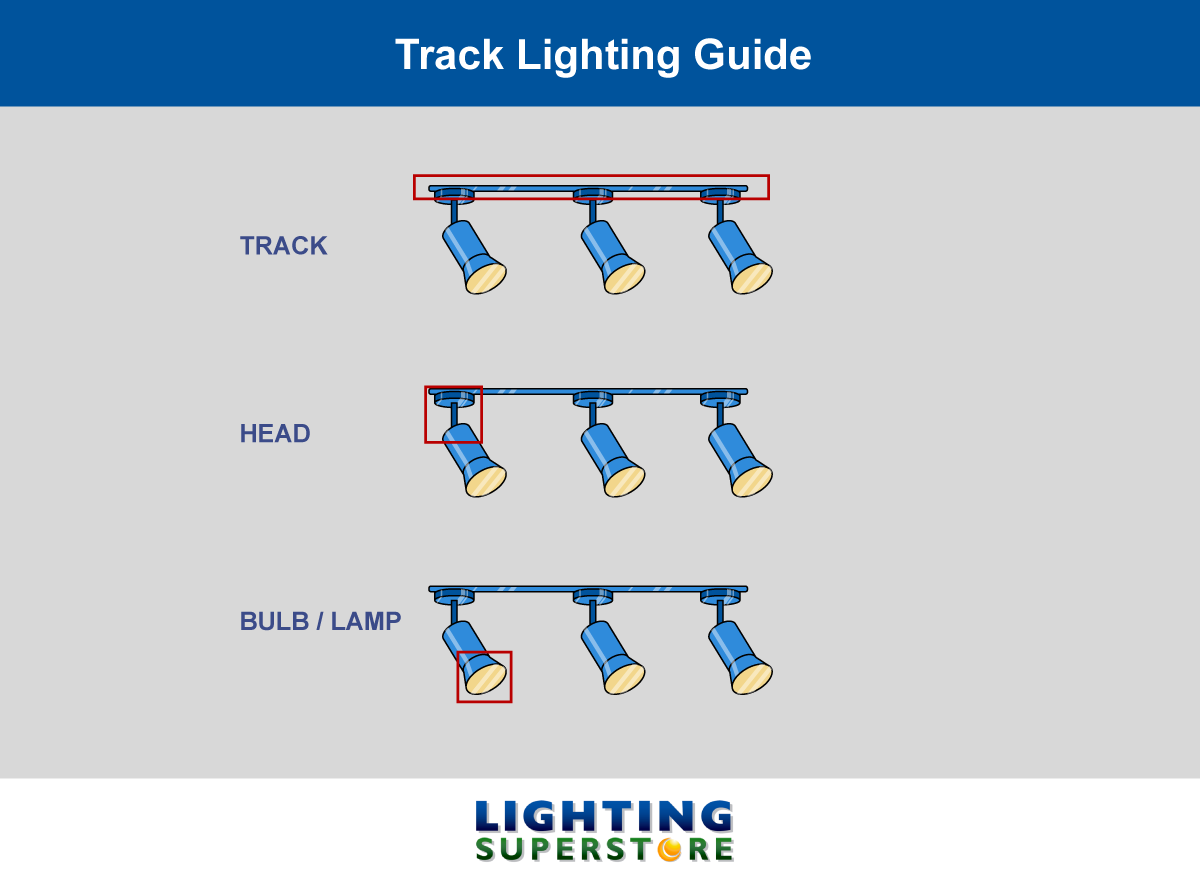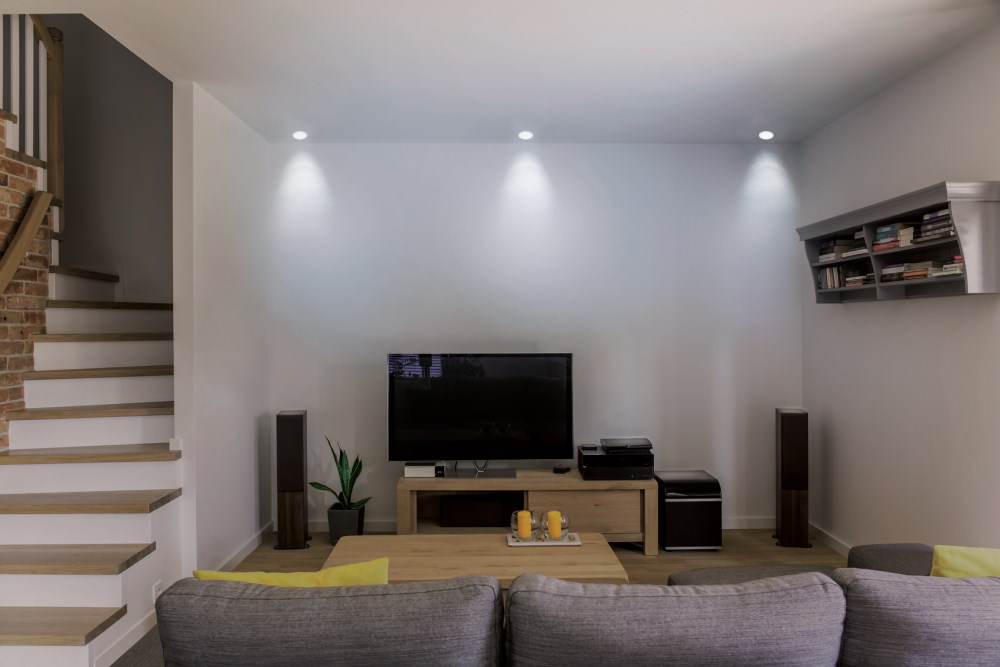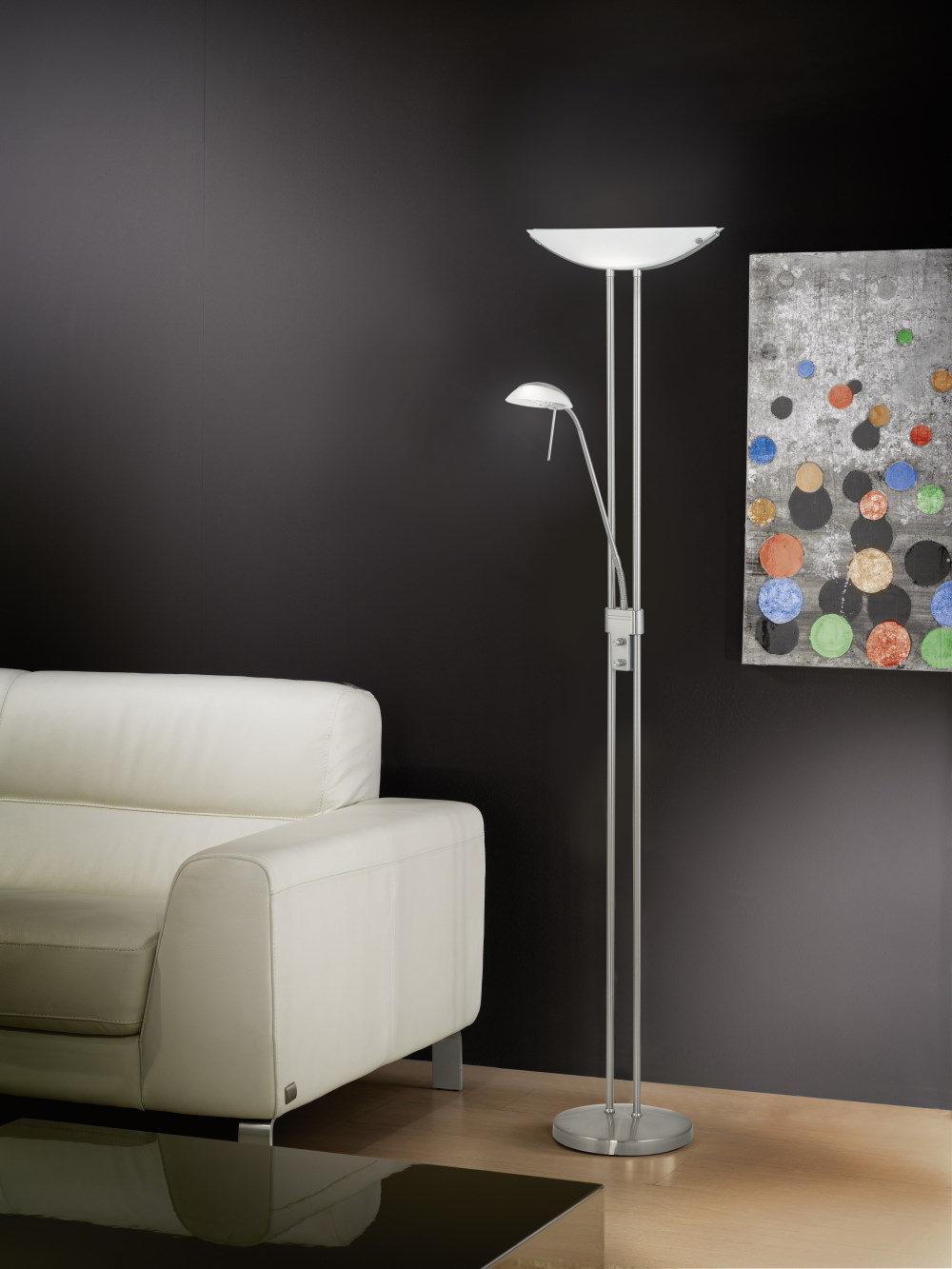Types of Lighting Fixture
When it comes to how your lights are fitted, there are a variety of options. Have a look at our guide below to find the ideal fixture type for your home.
Track fixtures

Track lighting refers to fixtures that all connect to one continuous powered track, as opposed to each bulb being wired up to the electrics individually.
There is a wide range available to choose from, making track fixtures a versatile design choice. The tracking is available in several lengths and, with the use of track connectors, can be custom-built to the size and layout of your home.
Practical and cost-efficient, track lighting works well in most rooms but performs especially well when highlighting artwork and collections or illuminating a workspace.
Installing track lighting fixtures is relatively simple, and their customisable nature means that you can update without too much hassle – feel free to add or remove lamps, within the safe wattage for the track (see end of article), and adapt the style of the lamps.
Components
Track lighting has three components:
-
Track – Mounted to the ceiling or wall. This is connected to the electricity feed and supplies power to every lamp attached, regardless of their position along the track.
-
Heads – the part that holds the bulb. These can be moved about to suit your lighting requirements, and come in different styles: step, round back, pinhole, gimbal, and pendant. LED track fixtures are ideal if you’d prefer more heads per track, as they have a lower wattage, meaning you can attach a higher number of them.
-
Bulbs – the part that emits the light. Reflector, dichroic, or GU10 are the most common bulb types for track lighting fixtures. If you choose to go for track pendant lighting in a bare-bulb style, try a visually pleasing bulb such as a GLS.
The three types of track lighting are H, J, and L. When choosing your components, first pick the heads, then choose a compatible track, and finally select your light bulbs. Each of these components must be compatible with the same type of fixture. For example, H heads will not function with a J track.
Installation
To install the fixtures:
- Plan the layout of your track lighting.
- Buy the correct number of track sections, as determined by your layout plan. You can buy connectors to join sections together.
- Ensure you have a power source that is compatible with your desired type of track lighting.
To review our track lighting products and accessories, please visit our Track Lighting page.
Pendant fixtures

Pendant lights are made up of bulbs that hang suspended from the ceiling. They are traditionally located in the centre of the room in order to light an entire space or, more recently, are commonly featured above tables or kitchen islands to provide task or accent lighting.
When considering placement for pendant lights, ensure that you adjust the cord length so that people don’t have to crouch to avoid them. Easy to update, this style of lighting fixture can move with the times if you update with new covers or lampshades.
For an increasingly fashionable and flexible option, consider a rise and fall pendant light. With these, you can easily adjust the pendant’s hanging height to suit your needs at all times. The downwards light output is focussed, and typically this style of pendant offers a dimmable option, perfect for creating an intimate and relaxing atmosphere.
If pendant lighting is what you are looking for, take a look at our wide range of pendant ceiling lights.
Recessed fixtures

Recessed lights, also known as can lights or downlights, are installed within a surface so that the actual fixture is hidden out of sight. Individually, they provide a small amount of light, so it’s best to have a collection of recessed lights in any given area.
Commonly found sunken into the ceiling, this style of fixture is ideal for rooms that lack the space for a hanging pendant light such as utility rooms and bathrooms.
Safety
There are three types of recessed lighting fixture, and it’s vital that you install the correct one - depending on the location of your lights:
-
Insulation Compatible (IC) fixtures – for where insulation comes into contact with the lighting fixture. Without IC rated fixtures, any contact with insulation can be extremely dangerous and poses a risk of fire.
-
Non-IC fixtures – for use only when there is another room above the ceiling where they are being installed. They are protected by a cover that holds any insulation away from the fixture to avoid a fire hazard.
-
Airtight (AT) fixtures – for where the lights are installed in a ceiling that connects directly to the roof. AT fixtures save money and energy waste by preventing the warm air generated by the lights to exit the building via the fixtures in the roof. If this is insulated, your fixtures must also be IC rated.
As hard-wired lights, recessed fixtures must be installed by a licensed electrician.
Components
Frame – this is placed between the ceiling joists in order to secure the light.
Housing – the cylindrical piece of metal that holds the light bulb and electrical pieces together within the ceiling. 6-inch housing is the most popular size.
Bulb – the light-emitting part. When choosing a bulb, consider what style of lighting you’re aiming for - as a narrow beam will produce a spotlight, whilst a wide beam allows a greater dispersal of light.
Trim – the visible part of recessed lighting. You can customise the size, style, colour, and material to complement the aesthetics of your room. However, do bear in mind that the style of the trim can impact the performance of the light:
|
Trim style |
Impact |
|
Eyeball |
Adjustable and able to produce any lighting style (ambient, accent, and task). Easy to position and alter. |
|
Baffle |
Popular and with reduced glare. Ideal style for kitchens and workspaces. |
|
Decorative |
Ornamental and customisable. Will suit high-visibility areas where the trim will be noticeable. |
|
Lensed |
A lens protects the bulb and electrics from moisture and water-damage - perfect for bathrooms. |
|
Reflector |
The reflective interior allows light produced by the bulb to be reflected, amplifying the light output. |
|
Wall-washed |
Angular and directional, this trim style is specifically designed to bathe walls in light. |
A stylish yet well-concealed option for lighting any room, recessed lighting gives you more floor space to furnish your home to suit you. If this sounds like what you’re looking for, you can view our range of recessed lighting options.
Portable fixtures

It’s all in the name; these are lights that aren’t permanently fixed to anything so can be moved amongst different locations as your décor or needs change. As with most light fittings, portable light fixtures can come with LED bulbs.
Some useful examples of portable lighting fixtures are desk and reading lights, and larger floor lamps. These can be used in conjunction with other lighting styles in order to give you a great ambience and a number of ways to effectively illuminate your space.
What is a safe wattage for a light fixture?
Every light fixture is assigned a maximum wattage rating, regardless of whether it is a permanent or portable fixture. This value must not be exceeded or else the fixture is at risk of overheating, which can potentially cause the insulation on the internal wires to melt. In extreme cases, this can result in the surrounding area becoming scorched.
To avoid this problem, always check the maximum wattage rating on your particular fixture before inserting a bulb. These are typically printed on the light bulb socket of the fixture. On fixtures that can hold more than one bulb, be sure to check whether the figure is for the individual bulb sockets or whether it refers to the maximum wattage for the fixture as a whole. Always use a light bulb that is equal to or less than the maximum wattage rate on your fixture.

